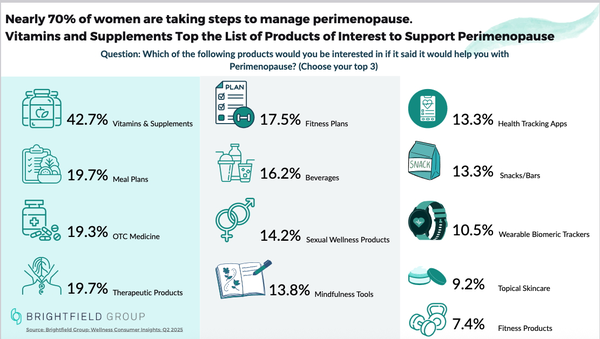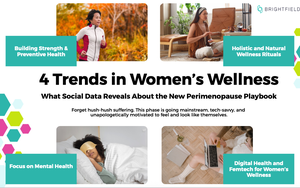
Perimenopause is the “new frontline of
women’s health,” states a new Brightfield Group study of females going through that life stage.
In fact, perimenopause has surpassed heart disease as a topic in Brightfield’s
social listening tracking as well as in Google Trends research, the report states.
Perimenopausal women, who range in age from the mid-30s to early 50s, are now over 42 million strong,
Brightfield says,
And yet, while many women undergoing fatigue, sleep issues, mood swings and other symptoms fail to link them to perimenopause, those who do are getting less self-conscious
about it.
Brightfield, whose results are based on a quarterly study of 5,00 U.S. adults as well as ongoing tracking of conversations across Twitter, Instagram and TikTok, cites four major
trends for brands to watch among perimenopausal women:
advertisement
advertisement
Building strength and preventative health.There’s a “surge connected to bone health” in social posts
related to perimenopause, “with growing buzz around more specialized ingredients like vitamin K and NAD, and a recent resurgence in bone broth,” noted Jen Kregor, Brightfield’s
director of product.
“Historically, bone loss was treated as a postmenopausal issue, something you would worry about later in life,” she said. “That framing began to shift
because a study showed that 20% of lifetime bone loss happens during perimenopause. The conversation's moved from frailty prevention to strength optimization much earlier in life.”
The
focus on bone health intersects with topics like longevity and daily actions, Kregor added, including “weighted-vest walks, vibration plates that are going to help with bone loading, and a
growing spotlight for functional ingredients like creatine and peptides.”
Holistic and natural wellness rituals. Rituals are moving from just physical practices like
walking, yoga and meditation to taking supplements like magnesium, adaptogens and probiotics, Kregor said.
One traditional ritual on the outs, Kregor added, is alcohol consumption. “That
had become part of so many women's end-of-the-day and it just doesn't work as well when you're entering perimenopause.”
Focus on mental health. “Mental health is at
the front and center for women in perimenopause,” stated Kregor, who pointed to the use of the #SuckingItUp hashtag being up 100%. “Nearly half are reporting high stress, 44% anxiety, and
nearly a third depression. Self-help and mindset tools are showing 133% year-over-year growth and digital mental health tools 56%.”
She added: “Nearly 2/3 of women's health
conversations include those indicators of emotional overwhelm,” but the “silence is certainly breaking…Symptom check-ins, sharing with humor and honesty, are trending.”

Digital health and femtech. Anappetite for
daily and personalized tools to feel better is “something we're hearing across the board, especially in mental health,” Kregor continued, noting that it’s “not
skyrocketing” but “growing with a nice volatility and consistency.” That shows that “mental health solutions, particularly ones with technology, are going to gain more
traction.”
The intersection of perimenopause and technology social mentions is “definitely growing and taking off,” at a rate of 79% Y-o-Y, said Kate Stevenson,
Brightfield’s director of client strategy. “That will continue to be something women expect as more millennials come into the conversation."
Stevenson said perimenopausal
women are over-indexing on use of Apple Watch, Fitbit, nutrition apps, and the Oura ring.
“Smart rings have really come into the space,” echoed Kregor. Oura ring has pivoted
towards the perimenopause market after being marketed primarily to athletes, she said, because the brand “recognizes that the biometrics and around heart data, sleep data, related cortisol are
all very informative for women to understand where they are in their hormonal health journey.”
Other tech growth areas, she said, include red light therapy, which is beginning to
demonstrate benefits for both strength as well as skin rejuvenation; blue light glasses for eye strain; and the reigning tech leader, fitness tracking. “Women are being more motivated
about managing their fitness, getting at least 150 minutes of exercise in a week, and seeing how that has an impact on their on their sleep and stamina.”